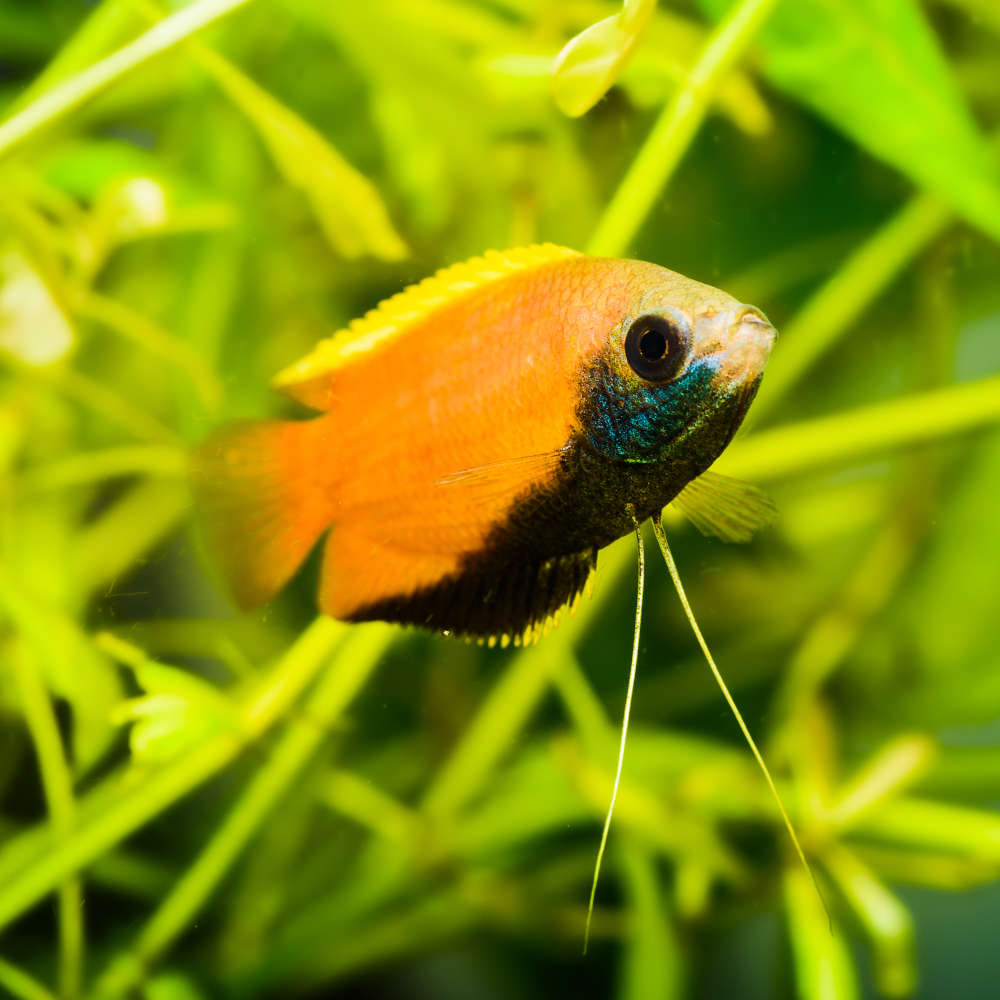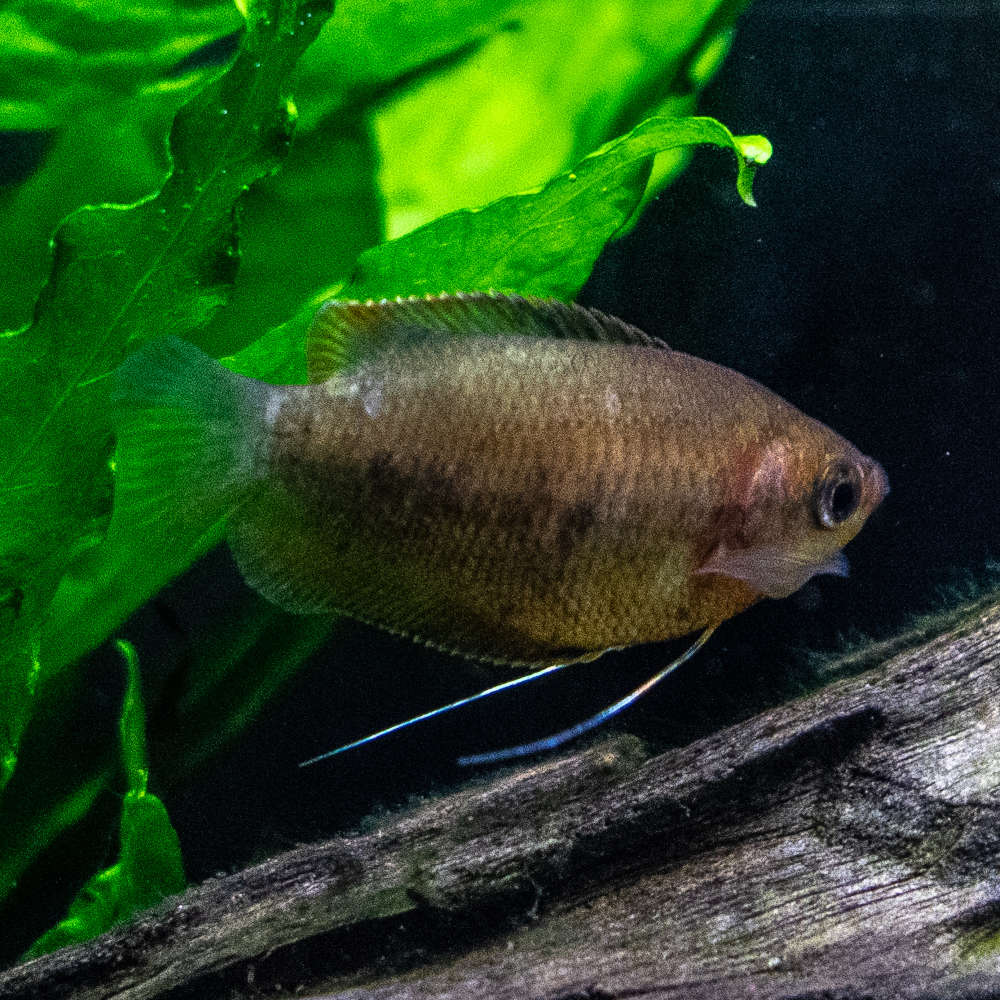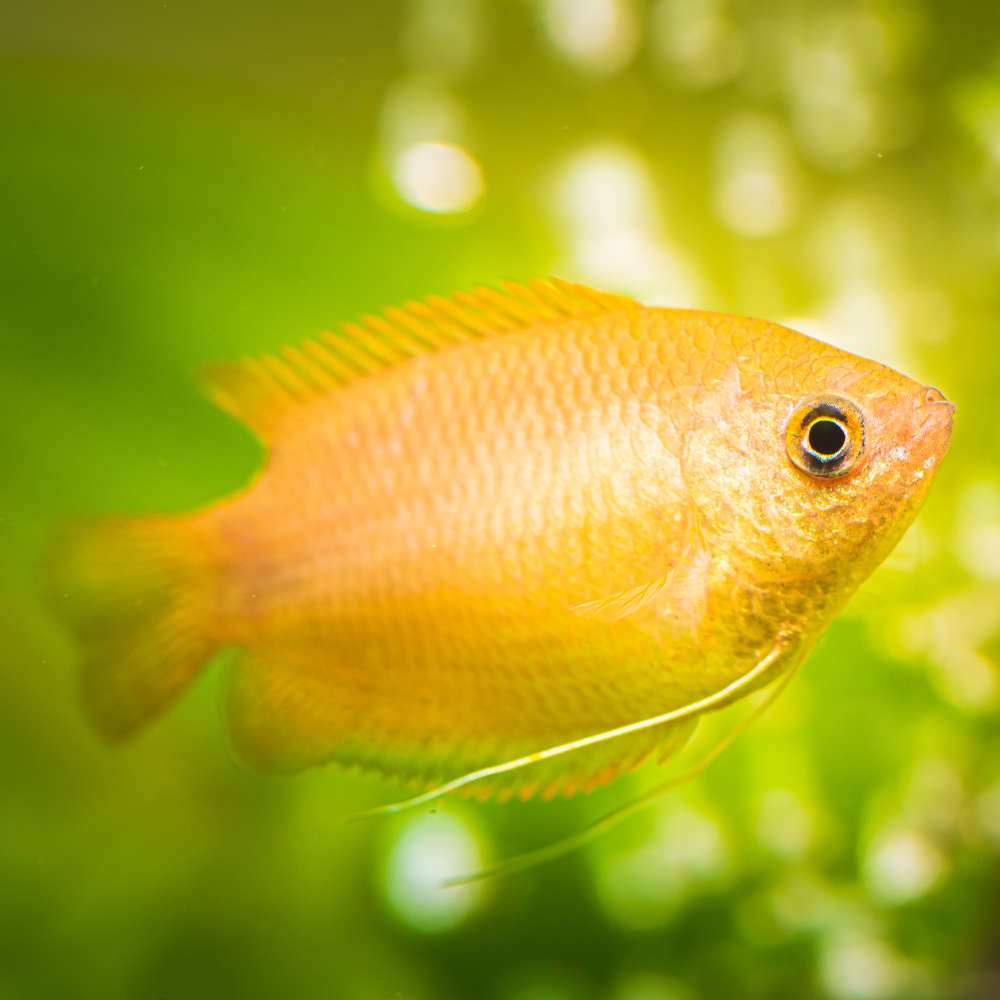If you want a bright-colored, hardy fish for your freshwater tank, honey gourami is a great choice. The beginner-friendly fish is loved for being low-maintenance and making zero fuss during meal times.
It can also be a great statement fish in a tank full of well-researched muted species. So, if you’re eager to bring it home, let’s learn more here!
What is Honey Gourami Fish?
Honey Gourami is a freshwater fish that belongs to the Osphronemidae family and is loved by the beginner fish keepers for its bright colors and calm nature.
| Origin | India, Bangladesh, Nepal |
| Order | Anabantiformes |
| Family | Osphronemidae |
| Scientific Name | Trichogaster chuna |
| Common Names | Honey dwarf gourami |
| IUCN Red List Status | Least Concern |
| Appearance | Female: silver grey/light yellow, light brown horizontal stripe, light gray fins Male: Bright honey-yellow/reddish-orange; gold dorsal fin; bluish-black face, throat, belly |
| Size (Adult) | Commonly 3.8-5.5 cm (1.5-2.2 in); Max: 13.7 cm (5.4 in) |
| Lifespan | Around 2-5 years, Max: 8 years |
| Temperament | Peaceful, timid, aggression among males |
| Tank Level | Top and middle dwellers |
| Water Temperature | 72-82 °F (22-28 °C) |
| pH Level | 6-8 |
| Water Hardness | Up to 15 dGH |
| Care Level | Easy |
| Minimum Tank Size | 10 gallons for 1 |
| Tank Environment | Well-planted, low flow, subdued lighting |
| Diet | Omnivorous with carnivorous preferences |
| Tank Mates | Own group, other bottom-dwelling, similar-sized, peaceful species |
What is the Natural Habitat of Honey Gourami Fish?
The honey gourami is native to the Ganges river of northern India, the Brahmaputra system of Manipur, Meghalaya, Assam, and Arunachal Pradesh, the delta and floodplain of Bangladesh, and a few places in Nepal.
In the wild, it also swims in low-altitude, densely vegetated still waters like ditches, ponds, flooded fields, and beels.
According to the 2009 assessment of The IUCN Red List, the species is labeled Least Concern.
Which family does Honey Gourami Fish belong?
The gourami belongs to the Osphronemidae family under the Anabantiformes order and is scientifically known as Trichogaster chuna. It’s popular worldwide as honey gourami and honey dwarf gourami.
Fun Fact: In 1822, the male and female honey gourami were given the scientific names Trichopodus chuna and Trichopodus sota, respectively.
How does Honey Gourami Fish look?

The fish has an extremely catchy appearance. So, let’s learn to identify it here!
What is the Size of Honey Gourami Fish?
Honey gourami usually grows up to 3.8-5.5 cm (1.5-2.2 in). However, rare specimens of up to 13.7 cm (5.4 in) were also spotted. The maximum reported weight of the fish is 25.4g.
What is the Color of Honey Gourami Fish?
The young fish has a silver-grey or light yellow body with a light brown horizontal stripe across the mid-body and light gray fins.
As the fish matures, the female fish retains this color. However, the male fish’s sides, anal and caudal fins, and rear region of the dorsal fin adapt to a bright honey-orange color. The front portion of the dorsal and anal fins show a yellowish margin.
He also shows a bright gold dorsal fin and bluish-black face, belly, and throat.
There are also some selectively bred ornamental strains of this fish, named red, golden, sunset, and red flame honey gourami. Most specimens in stores are selective-bred varieties.
What are the Features of Honey Gourami Fish?
This gourami has a compressed body, thread-like ventral fins, triangular tail fin, and touch-sensitive cells. It also has a labyrinth organ, which makes it a “facultative air breather”, i.e., it absorbs atmospheric oxygen into its bloodstream directly.
What is the difference between a male and a female Honey Gourami Fish?
The primary sexual difference in male and female specimens is their color. Check the “color” section to know more.
Other than that, the male fish is smaller than the female. The female is also more disc-shaped, and the male is more elongated.
When ready to mate, the male shows courting colors. His body and opercular zone take a bright orange color. His head, anteroventral region, and anal fin’s spiny rays become dark blue or black.
How does Honey Gourami Fish behave in the tank?
This is the most timid and calm gourami. It’s a great community tank species. However, the male of the slow-moving species – especially when breeding – is territorial.
It’s initially shy in a new environment but becomes active and energetic once familiarized.
What is the Lifespan of Honey Gourami Fish?
In general, the honey gourami lives up to 2-5 years. However, with the right water chemistry, a healthy diet, and keeping it in a large school, it may live up to 8 years.
Author’s Note: The gourami is extremely sensitive to noise and movement – even if it’s a tap on the aquarium. So, in my experience, it’s happiest when kept away from disturbance.
How to take care of Honey Gourami Fish?

If you want to bring this fish home, you must learn its basic needs to help it thrive the longest. So, let’s get started.
What is the Tank Size of Honey Gourami Fish?
If you want to keep one honey gourami, 10 gallons is enough. However, if you want a pair, you need a 20-gallon tank. Thereafter, you must add 5 gallons per extra fish. So, if you want a group of 4-6, opt for a 30-40 gallon tank.
What type of Water Chemistry is required for Honey Gourami Fish?
Though hardy, the fish is still water-sensitive. So, maintain these parameters at all times.
- pH Levels: 6-8
- Water Temperature: 72-82 °F (22-28 °C)
- Water Hardness: Up to 15 dGH
- Ammonia: 0 ppm
- Nitrite: 0 ppm
- Nitrate: Less than 25 ppm
What is the Tank Environment required for Honey Gourami Fish?
To make it feel at home and confident, you must also put in the right substrate, and plants, and also create suitable current. So, let’s know more about it here…
Which Substrate is needed for Honey Gourami Fish in the aquarium?
Honey gourami thrives in a variety of substrates. However, it prefers soft sand or fine gravel as they support growing plants – which is important for its tank.
To make the fish stand out, choose a dark substrate.
What types of Plants are required for Honey Gourami Fish tank?
Plants are a must-have in this fish tank to mimic its highly vegetated native habitat and decrease fights among conspecifics. It appreciates thick carpets, tall-stemmed, and floating plants.
Some great choices for plants are
- Microsorum
- Java moss
- Anubias
- Egeria
- Hydrocotyle
- Vallisneria
- Amazon sword
- Amazon frogbit
- Water sprite
What type of Lighting do Honey Gourami Fish prefer in the tank?
This gourami prefers subdued to moderate lighting, so use low-intensity lighting for at most 10 hours. Besides that, you must consider floating plants as they help disperse the lighting.
What is the Décor required for Honey Gourami Fish tank?
Use driftwood, plastic piping, empty camera film, and rock caves as the fish’s hiding spots. Add in some dried oak, beech, and Ketapang almond leaves to stain the water with tannins and establish microbe colonies as a secondary food source.
You can also add some aesthetic decor that doesn’t have any sharp edges.
Which type of filter is required for Honey Gourami Fish tank?
Use an air-powered sponge or cartridge filter for efficient filtration. You can also invest in air stones or peat filtrations. Perform 25% weekly water changes.
What is the Water Flow Rate for Honey Gourami Fish tank?
The fish belongs to gentle flowing streams, so maintain a weak current in the tank.
Care Tip: Don’t fill the tank with water to the brim. The fish needs a layer of humid air above the water level and some space to jump up to. So, add a lid as well.
What does Honey Gourami Fish eat?
The honey gourami is omnivorous with carnivorous preferences. Feed it mostly commercial fish food and supplement it with live or frozen food to retain the best colors. Some options are:
- High-quality flakes and pellets
- Brine shrimp
- Bloodworm
- White worm
- Daphnia
- Mosquito larvae
- Micro-cricket
- Fruit fly
- Chopped vegetables
Feed your fish 1-2 times every day. Avoid overfeeding to prevent health complications.
What are the Tank Mates for Honey Gourami Fish?
The honey gourami has a complicated temperament – shy yet territorial. It’s best to choose other quiet and muted-colored species. Some great tank mates are:
- Celestial pearl danio
- Kubota’s microrasbora
- Least rasbora
- Mosquito rasbora
- Dwarf rasbora
- Phoenix rasbora
- Kuhli loach
- Pleco
- Cory catfish (panda cory, pygmy cory, adolfoi cory)
- Molly
- Guppy
- Small barb
- White cloud mountain minnow
- Endler’s livebearer
- Sparkling gourami
- Otocinclus catfish
- Small rainbowfish
While this isn’t a schooling species, it’s best to keep 4-6 honey gouramis – an equal number of males and females – in a spacious, well-planted tank.
This encourages them to show their natural behavior. However, there will be one dominant male in the group that will chase the rest during meal times.
Never keep this fish in odd numbers. Otherwise, the singled-out fish gets bullied by couples. The male may also show aggression towards his mate. So, ensure there are lots of hiding spots.
Which Tank Mates to Avoid for Honey Gourami Fish?
As a rule of thumb, you must avoid any of the following kinds of fish in a honey gourami tank.
- Aggressive species: They’ll terrorize your pet.
- Territorial top-middle dwellers: They’ll get into a fight with your pet.
- Larger species: They may intimidate your pet.
- Colorful/flowing-finned species: Their excess color and flowy fins may stress the pet.
- Fin-nipping species: They may attack your pet’s fins.
Namely, some incompatible tank mates are
- Betta
- Jack Dempsey
- Oscar
- Tiger barb
- Clown barb
- Koi
- Dwarf gourami
- Tetra (neon, serpae, black skirt, white skirt, lemon, rosy, emperor, diamond, flame tetra)
- Cichlid
Some may suggest small tetras as good tank mates for your gourami. However, most tetras have fin-nipping tendencies, so don’t take any chances.
What are the Common Diseases in Honey Gourami Fish?
Honey gouramis are vulnerable to common bacterial and parasitic infections like ich, fin rot, and columnaris. Other than that, it also faces the following:
| Disease Name | Causes | Symptoms | Treatment |
|---|---|---|---|
| Impaction | Overfeeding, excess dry food consumption, parasitic infection | Appetite loss, No bowels, bloating, lethargy, discoloration, rectal prolapse | Feed less, reduce meal frequency, improve water quality, give fibrous food, reduce stress, give medicine |
| Velvet | Parasitic infection | Heavy breathing, clamped fin against its body, flashing, color loss, fatigue, poor appetite, yellowish film on the skin, skin peeling | Increase water temperature, keep lights dimmer for days, add medicine containing malachite green or aldehyde |
| Hexamita | Protozoan parasitic infection | Large holes/sores around head, poor appetite, color loss, red feces, trailing mucus | Start antifungal medicine treatment ASAP |
Quick Tip: Provide your gourami with a healthy, balanced diet, enough swimming and hiding spots, and the right tank mates to prevent most diseases.
How to breed Honey Gourami Fish in an aquarium?
Under the right setup and with enough care and vigilance, you can breed honey gouramis in captivity. So, let’s know all the steps here.
1. Pair Choosing
Honey gouramis form temporary pairs. If you already have one or more pairs in your tank, choose the most attractive and healthy-looking pair.
Many breed the fish in groups. However, the males are extremely competitive and territorial. So, breed one pair at once.
2. Breeding Tank Setup
In a 20-gallon tank, incorporate a small, gentle air-powered sponge filter for gentle flow, a heater, and a tightly fitting lid.
Use plenty of floating plants and stem plants on the water surface. This species is a bubble nest builder, which is usually built under floating leaves for stability. All bubble nests in bare water – unless in corners – break.
Fill the tank up to 20 cm (8 in) with water and maintain the following water chemistry:
- pH Levels: 7
- Water Temperature: 80-84 °F (27-29 °C)
- Water Hardness: Up to 8 dGH
3. Pair Conditioning
Introduce the pair in the breeding tank and condition them with several live and frozen meals. This will help the female grow plump with eggs and the male show courting colors.
4. Mating
The ready male builds the bubble nest and shows off his nest and colors to his mate. When receptive, she approaches the male. They touch each other with their ventral fins, and the male invites her over to his nest.
Spawning occurs right beneath the leaf, at the bottom. The male wraps his body around the female, and then she releases eggs and milt simultaneously. After that, the male transports all eggs to the nest. Each spawning produces 20 eggs, and up to 300 eggs are produced.
5. Separation
Post-mating, the male becomes territorial and protective of the eggs. He may attack the female, so rehouse her in the main tank.
Since the male takes care of eggs until hatching, let him stay. After hatching, remove him.
6. Incubation
In about 24-36 hours, the eggs hatch and fry live on their egg yolk. Within 3 more days, they become free swimmers.
Feed them infusoria and liquid fry food for the first week. Once they grow large enough, feed them microworm, daphnia, tubifex worms, and baby brine shrimp. When the juvenile fish is 5-6 months old, you can introduce adult fish food.
Breeding Tip: Fry are extremely sensitive, so be careful during water changes. Don’t let cold air drafts enter the tank for the first few months to help labyrinth organ formation.
How to buy Honey Gourami Fish?
Most captive-bred honey gouramis in the stores are selectively-bred or dyed. They’re difficult to differentiate sexually. Recently, several such specimens have been found to carry viruses.
So, insist on the stores to find you wild varieties. This might take time, but will be worth the investment and effort.
Check for these signs of good health in the fish:
- Good appetite
- No white spots, blemishes, or injuries
- Active swimming around middle-to-top levels – not lying at the bottom or hiding
- Clear eyes without bulging
- Bright scale colors
A word from FishInAquarium
The majestic-looking honey gouramis are active and playful. The eye-catching species love to dart around in your tank, which makes them fun to watch. So, get ready to bring these inexpensive buddies home!
If you enjoyed this article, share it with other enthusiasts. Show this underrated fish love together! Or, if you have more queries, drop us an email, and we’ll get back to you with answers.


